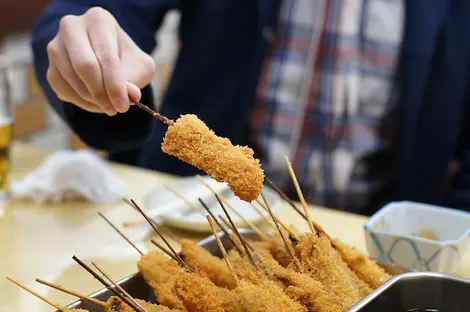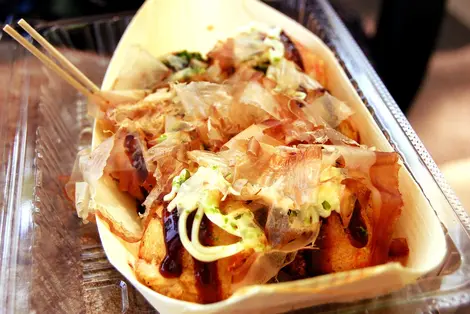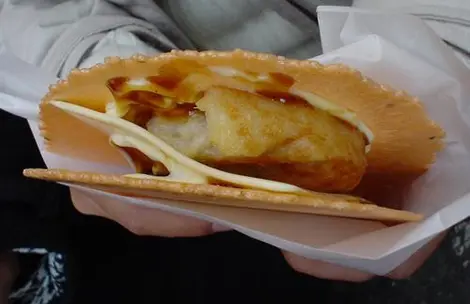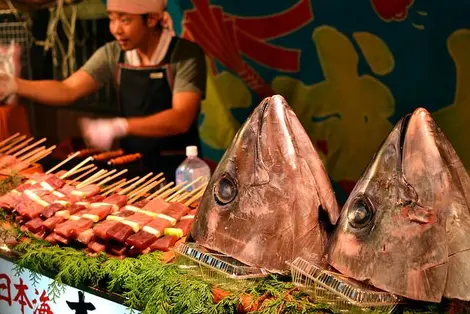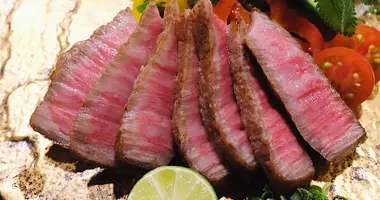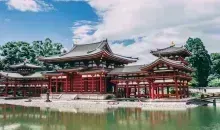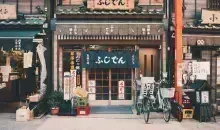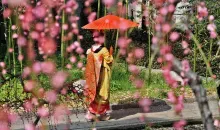Street food in Osaka: discover culinary delights to take away
- Published on : 13/07/2017
- by : O.D.
- Youtube
Gourmet to go
Osaka abounds in culinary specialties, making Japan's third-largest city a veritable street food capital. Nicknamed "kuidaore" or "eating to ruin", this expression perfectly illustrates Osakans' passion for street food. Vibrant districts such as Dôtonbori, Shinsekai and Namba are packed with stalls and restaurants offering a multitude of tasty dishes at affordable prices. To stroll the streets of Osaka is to embark on a unique gustatory journey, where colorful neon lights and giant signs guide you to unforgettable culinary experiences.
Takoyaki, Osaka's culinary emblem
Takoyaki is undoubtedly the emblem of Osaka street food. These delicious dumplings filled with pieces of octopus embody the culinary soul of the city. The preparation of takoyaki is a real spectacle: the cooks dexterously swirl the dough in special molds until they obtain perfectly golden balls. Served piping hot, the dumplings are topped with a caramelized sauce, mayonnaise, seaweed and shavings of dried bonito, which tremble under the heat.
Originating in the 1930s, takoyaki were invented by a chef named Tomekichi Endo, who was inspired by akashiyaki, a similar dish from nearby Akashi. Today, you'll find these delicacies all over Osaka, but the Dôtonbori district remains the ideal place to sample them. Well-known shops such as Wanaka and Aizuya offer some of the best takoyaki in the city. But beware: these dumplings are served extremely hot, so let them cool down a little before biting into them!
Variations on takoyaki and other seafood specialties
Takoyaki has inspired numerous variations that are well worth discovering. Takosen is one of the most original: a surprising sandwich made up of two senbei (rice cakes) topped with one or more octopus fritters. This version offers a crunchy alternative to the traditional tray in which takoyaki is usually served.
Osaka also offers other seafood specialties such as ikayaki, a thick pancake made from chopped cuttlefish and egg, topped with a brown sauce similar to that of okonomiyaki. You can also enjoy a variety of skewers: octopus, scallops or grilled fish can be enjoyed directly in the busy streets or at the Kuromon Ichiba market.
For the more adventurous, some stands offer more daring creations like cheezu takoyaki (with melted cheese inside), ebi takoyaki (with shrimp instead of octopus) or even sweet versions for dessert. These variations testify to the culinary creativity that characterizes Osalian gastronomy.
Kushikatsu: breaded skewers to suit all tastes
Another of Osaka's must-try specialties is kushikatsu, a breaded and deep-fried skewer of meat, fish or vegetables. These delicacies, crispy on the outside and tender on the inside, are particularly popular in the Shin-sekai district, considered to be their birthplace.
The variety of ingredients available is impressive: pork, chicken, shrimp, octopus, crab, but also asparagus, mushroom, cheese and even fruit for the sweet versions. This diversity makes kushikatsu an ideal choice to satisfy all palates, including those of vegetarians. The preparation method is simple but effective: ingredients are threaded onto bamboo skewers, coated in flour, dipped in a mixture of beaten eggs and then breaded before being deep-fried to a perfect golden color.
To enjoy kushikatsu like a true Osakian, you need to dip them in a dark, sweet sauce served in a small communal container. But beware of local etiquette: it' s strictly forbidden to dip your skewer a second time after you've tasted it! If you need more sauce, use the fresh cabbage leaves usually served as a side dish.
Kuromon Ichiba market, a street food lover's paradise
Nicknamed "Osaka's kitchen", Kuromon Ichiba Market is a must-see for all foodies. This historic indoor market, whose origins date back to the Meiji era (1868-1912), stretches for almost 600 meters and houses over 150 stalls and stores. Under its arcades adorned with red and yellow stained-glass windows, you'll discover an impressive variety of fresh produce and prepared dishes.
The market is particularly renowned for its seafood stalls, where you can sample fresh oysters, crab skewers, sea urchins and fugu (the famous puffer fish that requires preparation by certified chefs). You'll also find stalls selling grilled wagyu meat, fresh vegetables, spices, seaweed and, of course, all Osaka's street food specialties.
For the best experience, arrive early in the morning (around 9am) to avoid the crowds and enjoy the freshest produce. The great thing about Kuromon Ichiba is that you can easily put together your own tasting circuit , sampling a variety of dishes from one stall to the next. Don't hesitate to make several trips around the market before deciding what to eat, as the options are numerous and each more tempting than the last!
Where to enjoy the best street food in Osaka
Osaka offers several emblematic districts in which to savor its legendary street food. Dotonbori remains the benchmark, with its colorful neon lights, giant signs and impressive concentration of stalls and restaurants. This lively canal-side thoroughfare can be recognized by its extravagant sculptures, such as the Kani Doraku restaurant's famous giant crab or the Glico Man runner. The nearby Hozen-ji Yokocho shopping street offers a more traditional atmosphere, with its red lanterns and small stalls.
The Shin-sekai district is the ideal place to sample authentic kushikatsu in a retro atmosphere reminiscent of Japan in bygone years. Dominated by the Tsutenkaku tower, this popular district in the south of Osaka offers a complete immersion in local culinary culture. The emblematic Kushikatsu Daruma, recognizable by its mustachioed cook mascot, opened its first restaurant here in 1929.
To discover Osaka's culinary specialties in a more relaxed setting, the Namba district abounds with izakayas (the Japanese equivalent of pubs) where you can enjoy gyozas, ramen and small dishes to share. If you prefer a more organized approach, a number of guided gastronomic tours are available, allowing you to discover the best spots while benefiting from cultural explanations.
Practical guide to street food in Osaka (budget, opening hours, good addresses)
Best times to sample street food: If you want to avoid the crowds, opt for a morning visit to the Kuromon Ichiba market and an early afternoon visit to Dotonbori. On the other hand, to enjoy the electric atmosphere and illuminations for which Osaka is famous, there 's nothing like an evening stroll through its emblematic districts. Most stalls and restaurants are open from 11am to 10pm, with variations depending on the establishment.
Budget and good addresses: Street food in Osaka is generally cheap to eat in Japan. Count between 400 and 600 yen for a portion of takoyaki (6-8 pieces), 700 to 1200 yen for okonomiyaki, and 100 to 250 yen per kushikatsu skewer. For takoyaki, don't miss Wanaka in Dotonbori or Takoyaki Juhachiban, renowned for its particularly soft dumplings. Fans of kushikatsu should head for Kushikatsu Daruma in the Shin-sekai district, while okonomiyaki specialties are excellent at Chibo or Ajinoya.
A few practical tips for an optimal experience: prefer to pay in cash, as many small stands do not accept cards. When ordering, don't hesitate to point or show photos if you don't speak Japanese. Learn a few useful expressions like "Oishii" (delicious) or "Sumimasen" (excuse me). Finally, respect local etiquette by eating your food close to the stand where you bought it, rather than walking while eating, which is not common in Japan.
To complete your culinary experience, don't forget to also discover the culinary specialties of the matsuri if you're lucky enough to visit Osaka during a traditional festival. These events are an opportunity to taste specific seasonal dishes and experience Japanese gastronomy in a typical festive atmosphere.





